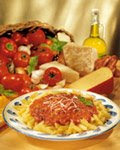
Chiang Mai is a city in the North-east of Thailand. the city is culturally very close to Laos. It is famous for its chicken salad, which was originally called "Laap" or "Larp". Duck, beef or pork can be used instead of chicken.
Recipe: (Serves 4 - 6)
450 g/1 lb minced (ground) chicken
1 lemon grass stalk, root trimmed
3 kaffir lime leaves, finely chopped
4 fresh red chilies, seeded and chopped
60 ml/4 tablespoons fresh lime juice
30 ml/2 tablespoons Thai fish sauce
15 ml/1 tablespoon roasted ground rice
2 scallions (spring onions), finely chopped
30 ml/2 tablespoons fresh coriander (cilantro) leaves
Thinly sliced kaffir lime leaves, mixed salad leaves and fresh mint sprigs, to garnish
Method:
Heat a large, non-stick frying pan. Add the minced chicken and moisten with a little water. Stir constantly over a medium heat for 7-10 minutes, until it is cooked through. Remove the pan from the heat and drain off any excess fat. Cut off the lower 5 cm/2 in of the lemon grass stalk and chop it finely.
Transfer the chicken to a bowl and add the chopped lemon grass, lime leaves, chilies, lime juice, fish sauce, roasted ground rice, scallions and coriander. Mix thoroughly.
Spoon the chicken mixture into a salad bowl. Sprinkle sliced lime leaves over the top and garnish with salad leaves and sprigs of mint.































